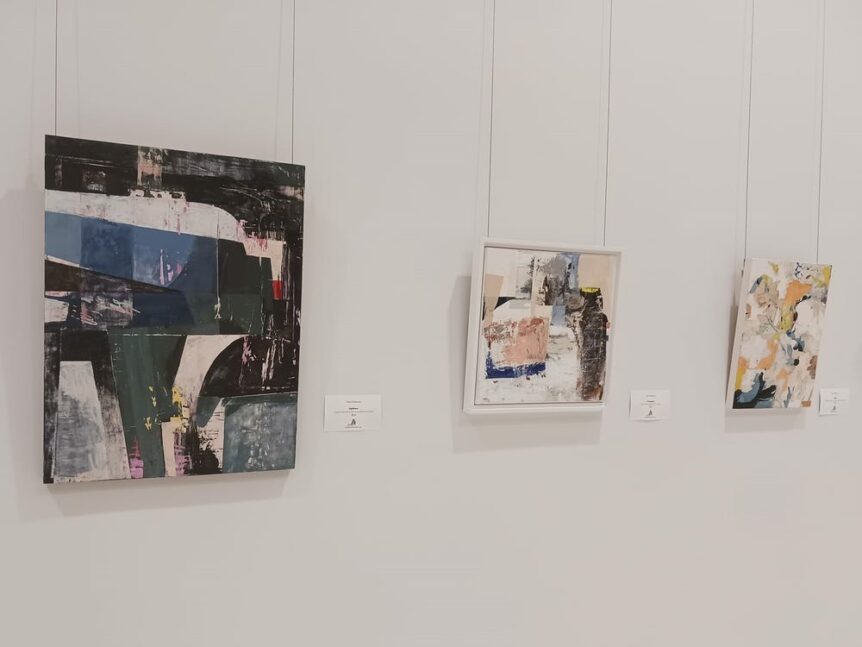View story at worcestermag.com
By Margaret Smith
Photo: Margaret Smith
As a graphic designer for more than 20 years, artist Katie Goldstone of Westborough earned a bachelor in fine arts from the University of Delaware. About five years ago, Goldstone said, “I started moving back toward my first love and creative outlet in painting and collage that I was developing in my college studies. The pandemic, and particularly the lockdowns, had me thinking about spaces and environments.”
Goldstone added, “I began creating imagined, environmental spaces meant to place the viewer within layers of history. Similar to an excavation, adding and removing sections of the painting reveals the assembled archives of experiences, time and a sense of being.” If you work at or visit the Mercantile Center, where Worcester Magazine’s office is located, you might see Goldstone’s work on display, on view through February.
The showing is part part of the ArtsWorcester Art@Work corporate art exhibition program, designed to enhance business spaces with the works of local artists.
Goldstone’s work “Building and Bridges” is included in the online art gallery Art Fluent, in the exhibition “Wanderlust.” She is a member of ArtsWorcester, where she has exhibited, and her work has been published in multiple issues of Contemporary Collage magazine.
Goldstone recently spoke with Worcester Magazine and said of the artist’s experience: The lifelong act of mark-making pushes me to consistently work with different tools and substrates including found objects and materials to discover new and often unexpected results from my experimentation. Feeling excited to create something new or waking up in the morning and immediately wanting to continue on a piece that I suddenly feel like I have a solution for. I am always chasing a new and exciting interplay of shapes, colors and textures to create a cohesive, dynamic composition.”
What artistic media do you like to work with the most?
I work with various materials, which include vintage papers, acrylic paint, pencil, watercolor, and have even been known to pull rusted bits of metals from guardrails or old paint from walls. I work on surfaces that speak to the direction of the piece, from paper to canvas to wood panels. I use materials to get the effect that I am looking for, which is typically worn and weathered, contrasted with some sharper areas of clarity. I work with many layers to ultimately produce what feels like a well-balanced composition with interesting details and exciting, unexpected marks.
Please tell me about your current exhibit or exhibits.
I have eight pieces on loan at the Mercantile Center until the end of February 2025. My work “Building and Bridges” is included in the online art gallery Art Fluent, in their exhibition “Wanderlust.” I have also exhibited at Arts Worcester and my work has been published in multiple issues of Contemporary Collage magazine. An abstract surface design of mine was recently endorsed by Katie Couric and Bobby Berk as one of their favorite holiday gifts. The design is available on an assortment of products such as tote bags, tablecloths and napkins.
Your bio mentions the influence of nature and bodies of water. Can you tell me more about that?
I continue to find myself creating abstract landscapes of sorts, often imagining that I am looking at something from an aerial view. These topographic environments are ultimately created from combinations of shape, line, color and texture. I’m often inspired by something like the texture and color of bark on a tree or shapes that I see in a lake, looking at it from above. Taking long walks with my dog, I discover materials, both man-made and organic, which are either used in the art or are influential to the outcome.
Your bio also mentions new, “happy accidents” of experimentation. Can you share some examples?
Experimenting is a core part of my artmaking practice — whether it is pulling a print off of a gelli plate, which typically produces fairly unexpected results, or using an unusual tool from a hardware store or kitchen cabinet, directly on a piece, to produce an unpredictable mark. Layering transparent materials and stripping away parts also often creates surprising outcomes.
When and where did you first begin to learn and study art?
Winning the fire-prevention drawing contest in second grade seemed to be the catalyst for my burgeoning interest in art. Eventually, I was presented with the best artist award throughout elementary school, which increased my confidence and seemed to have an influence on my future with art. I was always drawing and painting throughout my life but decided to major in fine arts in college, ultimately choosing painting as a concentration.
A friend (and arts teacher) was expressing that abstract art is much more difficult than it might appear, because the artist is conveying a feeling or experience that is not represented concretely. What are your views on abstract art?
I have always been drawn to, and preferred creating, abstract art. For me, abstract art is something you can get lost in and creates an exciting, unknown world of its own. I am enamored with texture. The contrast of more defined areas combined with distressed ones is what is really exciting for me. Art that has many layers that create depth and a combination of marks, color, shape and texture is what sparks my interest.
Is there an artistic project or endeavor you would like to pursue?
Sharing a sketchbook with another artist who has a similar aesthetic to mine and continuing to add to each other’s work to see what becomes of it is an exciting prospect to me!
What is the hardest part of being an artist?
The isolating and unpredictable nature of it. You spend a lot of time alone as an artist, which I enjoy, but also wind up craving social interaction. I’m a bit of an introvert/extrovert combination, so the alone time can be a blessing and a curse.
What is the most joyful?
Allowing myself to just play and getting completely lost in the creative process.

